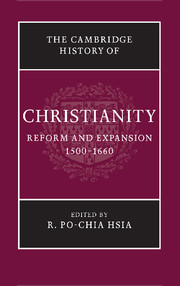Book contents
- Frontmatter
- Part I Luther and the Holy Roman Empire
- Part II The Second Reformation
- Part III Catholic Renewal
- Part IV Resolving Confessional Conflicts
- Part V Religion, Society, and Culture
- Part VI Christianity and Other Faiths
- 26 Christianity and Judaism
- 27 The naturalization of Andean Christianities
- 28 Between Islam and Orthodoxy: Protestants and Catholics in south-eastern Europe
- 29 Christianity shaped by the Chinese
- 30 Reception of Hinduism and Buddhism
- Bibliography
- Index
- References
30 - Reception of Hinduism and Buddhism
from Part VI - Christianity and Other Faiths
Published online by Cambridge University Press: 28 March 2008
- Frontmatter
- Part I Luther and the Holy Roman Empire
- Part II The Second Reformation
- Part III Catholic Renewal
- Part IV Resolving Confessional Conflicts
- Part V Religion, Society, and Culture
- Part VI Christianity and Other Faiths
- 26 Christianity and Judaism
- 27 The naturalization of Andean Christianities
- 28 Between Islam and Orthodoxy: Protestants and Catholics in south-eastern Europe
- 29 Christianity shaped by the Chinese
- 30 Reception of Hinduism and Buddhism
- Bibliography
- Index
- References
Summary
In 1585, the Third Ecclesiastical Council of Goa, the hub colonial town of Portuguese India, issued an official declaration stating that some of the native Christians, who were recent converts, kept on moving out of the Portuguese territory into the ‘infidel’ hinterland in order to ‘return to the caste [tomar casta]’ by performing ‘diabolical rites of the gentiles’. The way this is done is by going on a pilgrimage to some Pagodas (the temples) and by carrying out ceremonies of expiation helped by their Brahman priest (bragmanes sacer-dotes) and, finally, by drinking ‘foul drinks [immundicias]’. These apostates then return to Goa and live among the Christians, which causes scandal, because performing such rituals was considered an act in ‘detestation of the faith [em detestação da fé]’.
What may appear as a confusion for our contemporary sense of conversion and apostasy is the fact that in the sixteenth and seventeenth centuries caste and religious beliefs of the non-Christian population in India seem to be confounded and interchangeable according to the Portuguese colonial and ecclesiastical administrations. Moreover, the name and concept of ‘Hinduism’ as a religion of all Hindus does not exist during this period. Even the name ‘Hindu’, or ‘indo’, is a scarce word in Portuguese texts and deserves a history of its own. In spite of the lack of use of familiar terms, it is safe to claim that the Portuguese did have a sense that these people, whom they simply called the gentiles (gentios), practised some kind of separate religion, but what exactly it was and how to go about uncovering its secrets was far from clear.
- Type
- Chapter
- Information
- The Cambridge History of Christianity , pp. 577 - 597Publisher: Cambridge University PressPrint publication year: 2007
References
- 1
- Cited by



